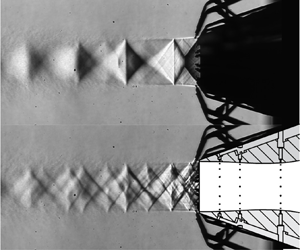Published online by Cambridge University Press: 02 December 2022

This study demonstrates an experimental platform for active jet noise reduction comprising of an automated system that performs a search for the optimal actuator locations and parameters, powered by a genetic algorithm (GA). Sideline noise reduction levels of 7.3 dB were achieved for a cold overexpanded (nozzle pressure ratio,  $NPR=2.8$) jet, beyond the state-of-the-art for jet noise reduction with air injection. The reduction in noise was achieved at a mass flow rate of 1.4 % of the main jet, requiring no prior knowledge of the flow physics to inform the placement of the actuators. The same actuator pattern was tested in hot conditions (nozzle temperature ratio,
$NPR=2.8$) jet, beyond the state-of-the-art for jet noise reduction with air injection. The reduction in noise was achieved at a mass flow rate of 1.4 % of the main jet, requiring no prior knowledge of the flow physics to inform the placement of the actuators. The same actuator pattern was tested in hot conditions (nozzle temperature ratio,  $NTR=1.88$), achieving 4.7 dB sideline noise reduction. Detailed examination of the solutions obtained unveils some of the mechanisms leveraged by the GA to accomplish these high levels of noise reduction through microphone measurements and schlieren flow visualization. The GA found that actuating at the diverging wall of the convergent–divergent nozzle, where flow is supersonic, is very effective when combined with air injection near the nozzle lip, outside of the nozzle. Although the external actuation is effective at eliminating the screech tone, it is by actuating inside the nozzle at the diverging wall that sufficient disruption of the shock cell train can be achieved in order to reduce the broadband shock-associated noise.
$NTR=1.88$), achieving 4.7 dB sideline noise reduction. Detailed examination of the solutions obtained unveils some of the mechanisms leveraged by the GA to accomplish these high levels of noise reduction through microphone measurements and schlieren flow visualization. The GA found that actuating at the diverging wall of the convergent–divergent nozzle, where flow is supersonic, is very effective when combined with air injection near the nozzle lip, outside of the nozzle. Although the external actuation is effective at eliminating the screech tone, it is by actuating inside the nozzle at the diverging wall that sufficient disruption of the shock cell train can be achieved in order to reduce the broadband shock-associated noise.